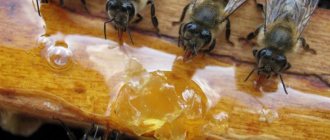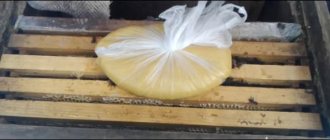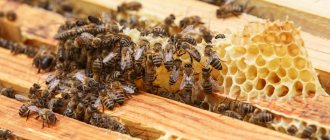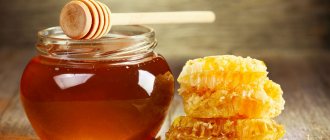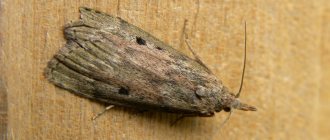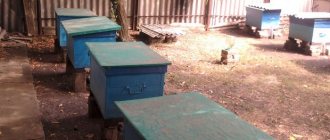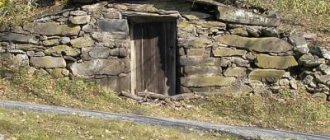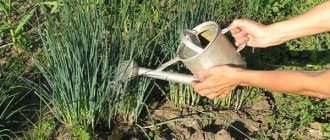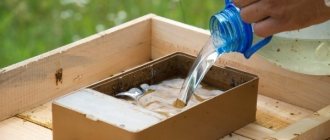Invert syrup is a nutritious food for bees made from sugar. It is popular among beekeepers due to its usefulness and ease of preparation. If there is a shortage, absence of honey plants, or beekeepers select honey, the inhabitants of the hive do not have enough carbohydrates. After all, they consume them from honey, a natural food. In this case, invert feeding will be needed.
This carbohydrate product is convenient to use, has a long shelf life, is easily digested by bees and does not crystallize. Many beekeepers have already become familiar with this product and know how to prepare invert syrup for bees in compliance with all the rules. This can be done at home.
Invert syrup
Advantages of using invert syrup in beekeeping
In their natural habitat, natural honey serves as a source of carbohydrates for bees. It is rich in various nutrients:
- organic acids;
- amino acids, glucose;
- fructose;
- minerals.
The product is able to provide the bee colony with sufficient energy and helps insects survive the winter. If there is no honey or there is not enough honey to feed the swarm, it may die.
Lack of honey most often causes a lack of honey plants, but sometimes a deficiency is caused artificially by sampling honey by a beekeeper. In this case, for the normal functioning of the family, it is necessary to provide the insects with another source of food. To do this, various fertilizers and artificial nectar substitutes are introduced into the diet of bees in the apiary, which the insects subsequently process into honey. In particular, sugar inversion is widely used to feed bees.
The following advantages of this method of feeding bee colonies can be highlighted:
- the chemical composition of such feeding is as close as possible to natural honey, so that replacing a natural product does not cause disruption of the digestive processes of bees;
- in the process of processing the mixture, there is no wear and tear on the working individuals, which often leads to their rapid death;
- after wintering, bees fed in the fall live much longer than their relatives who ate ordinary sugar syrup;
- the product is widely used to strengthen weakened bee colonies and their further development;
- invert sugar syrup is the best replacement for low-quality honeydew honey, which is produced at the end of summer due to a decrease in honey yield;
- unlike many other types of feeding, sugar invert retains its beneficial properties for a long time, which is why you can prepare large portions of the product at once, gradually consuming the material later;
- Honey obtained from invert is not subject to crystallization, and therefore is always suitable for consumption by insects - bee colonies winter well on this type of food.
Important! The cost of sugar invert is much lower than honey, which is beneficial from an economic point of view.
What additives can be used in syrup for bees: 3 types
Various drugs are added to the syrup to prevent diseases and strengthen bee colonies. For example, in August, 20 mg of fumagilin is added per 1 liter of feeding - this is a good way to prevent nosematosis.
To invert a sugar solution, 3 types of substances are used:
- organic acids (citric, lactic, acetic),
- honey (candied or unripe can be used),
- “Pchelit” is an enzyme-yeast preparation.
What is the difference between invert syrup for bees and sugar syrup?
The process of preparing invert syrup for feeding bees involves inverting sugar. This product differs from ordinary sugar syrup in that the sucrose in it is broken down to the level of glucose and fructose. This is why food acids (lactic, citric), honey or industrial invertase are added to the sugar mass.
It is generally accepted that such carbohydrate feeding has an extremely beneficial effect on the life of a bee swarm. This is explained by the fact that insects spend less effort on digesting the product - sugar invert is absorbed quite quickly. Moreover, eating ordinary sugar syrup causes premature depletion of the enzyme system in bees. This leads to a rapid decrease in the volume of the fatty body of insects and their rapid death.
When sugar invert with various food additives is introduced into the diet of a bee colony, insects live longer and have better resistance to many diseases.
Is it possible to feed bees fermented honey?
People who are keen on beekeeping argue that feeding spoiled food is considered unacceptable, as it can cause digestive upset in bees and, as a result, their death.
The lifespan of bee colonies directly depends on the quality of food, so it is important to choose high-quality products for feeding them. Above are a number of recipes for inverted syrup, which is well absorbed by insects and is second only to natural honey.
How to make invert syrup for bees
Invert syrup for bees is made in different ways: with the addition of honey, industrial invertase, lactic and citric acid, etc. In this case, the raw materials used to prepare the fertilizer must meet certain characteristics:
- Sugar for preparing inverted honey is used according to GOST. Yellow or brown sugar (raw) is not suitable, nor is powdered sugar. In this case, small grains of sugar will not be able to sink to the bottom and will ultimately become centers of crystallization of the invert, that is, the product will be more susceptible to sugaring.
- All fertilizer additives must be of high quality.
- Honey used as an additive to the product must be collected no more than a year before the preparation is made.
- Honey that has been exposed to high temperatures in the past should not be used.
- In the same way, honey, which contains foreign impurities, is unsuitable for preparing inverted fertilizing.
- It is especially important to observe the proportions of the ingredients used when preparing sugar invert for bees. Insects do not respond well to feeding with too thick honey, since in this case they spend a large amount of additional moisture to break down the product to a more diluted consistency. On the other hand, honey that is too thin is also unsuitable for feeding bee colonies. The fact is that such food is more difficult for insects to digest; its assimilation requires a lot of time, which greatly weakens the swarm. In some cases, the bee colony may even die.
- Invert honey should not contain any infectious agents, that is, it must be sterile.
Depending on what substance is used to prepare the invert syrup for the bee colony, the final product can vary greatly in its usefulness for insects. The most popular additives for invert are:
- Food acids. This is a classic option. Citric, acetic or lactic acid is added to sugar syrup. This food is cheap, accessible and easy to prepare, however, its nutritional value is significantly lower than that of sugar invert created on the basis of industrial invertase or honey.
- Honey-sugar invert is healthier than fertilizing with added acids due to the high content of natural invertase in honey, which insects add to nectar. In addition to carbohydrates, this food also contains amino acids, vitamins and mineral components.
- Sugar syrup, inverted using industrial invertase, is considered the highest quality option for feeding bee colonies, which is second only to natural honey in its usefulness. The product is distinguished among other types of food by its high content of nutrients and a deeper level of breakdown of all its components.
Why is syrup used?
Special food for bees has the following properties:
- The final product does not change its color or taste. Organic acids and fruit flavors contained in the product interact with fructose, which the invert syrup contains. Often this component is used in the production of juices, drinks and other liquids where it is necessary to preserve the smell and taste of added fruit. At the same time, the aroma will not fade over time;
- The hygroscopicity of invert syrup is noted. The moisture absorption rate is high. It is a kind of sponge where moisture is retained for wetting. As a result, the final product can be stored longer, does not become stale, or dry out. The inverter composition is used in the confectionery industry. It is used to prevent drying of foods that contain little fat: cakes, diet cookies, bread, pastries. If these products dry out, their presentation is lost. Also, under the influence of liquid, sweets and fudge do not crack. Traces can be found in soft candies, marmalade, and marshmallows. A candied crust does not form;
- Water binding occurs. Foods that contain large amounts of water require special formulations to remain soft. The product stops becoming stale and remains moist;
- There is no crystallization of sugar in the inverter type composition;
- Food in the freezer does not freeze due to the action of the substance in question. When adding invert syrup, the freezing point decreases and ice crystals do not form. This is very helpful when creams and mousses prepared using milk are stored in the freezer;
- The syrup is soluble in water. Its dissolution occurs at any liquid temperature;
- Fructose, which the invert solution contains, gives the liquid sweetness. As a result, under the influence of fructose, it is possible to reduce the carbohydrate content in the final products. The figure reaches up to 20 percent. This significantly reduces production costs;
- Under the influence of invert syrup, the activity of the aquatic environment decreases and high osmotic pressure is maintained. Since microorganisms multiply quickly in water, a substance is needed. Which can inhibit the growth of pathogens, prevent aging and damage to the product. Fructose and inverter syrup act as preservatives. The shelf life of the final product increases, which makes it possible for sweets and preserves to remain suitable for food longer;
- When heated, a chemical reaction occurs between proteins and sugars. As a result, the resulting mass changes color, becomes brown, and a color and smell appear. The process is called the Mayer reaction. Under the influence of feeding, it becomes brighter. This effect is used in baked goods to give the product a beautiful brown color and better taste;
- The composition in question is fermented with yeast, this process is easy.
It is worth noting that inverter liquid is not used when making caramel candies, since it will absorb water, which is unacceptable for the product.
How to Invert Sugar Syrup for Bees
The proportion of the solution is of great importance in the inversion process. Inverted sugar syrup for bees can be prepared with the following percentages of ingredients:
- 40% (sugar to water ratio 1:1.5) – this feeding is suitable for stimulating egg laying of the uterus;
- 50% (1:1) – invert with this concentration is used in the summer months in the complete absence of bribes;
- 60% (1.5:1) – the product is poured into feeders in the fall to better prepare the bee swarm for wintering;
- 70% (2:1) – fertilizing is introduced in exceptional cases in winter.
Regardless of what substance is used as an additive to invert sugar, the method of its preparation remains virtually unchanged. Soft drinking water is brought to a boil and the required amount of raw materials is added to it. Then the solution is stirred until the sugar grains are completely dissolved.
How to make invert syrup for bees with added honey
Honey is one of the most common food additives used when making your own invert syrup for bees. With the addition of honey, the syrup is inverted according to the following scheme:
- 7 kg of sugar is poured into 2 liters of water.
- Then the thoroughly stirred mixture is diluted with 750 g of honey and 2.4 g of acetic acid.
- Next, the solution is kept at a temperature not lower than 35°C for 7 days. All this time the product is stirred 2-3 times a day.
- When the foam subsides and the amount of crystallized sugar is reduced to a minimum, the invert can be poured into containers.
Inverted sugar syrup for bees with citric acid
This recipe for invert syrup for bees is quite popular:
- 7 kg of sugar is poured into 6 liters of hot water.
- The resulting mixture is thoroughly stirred and 14 g of citric acid is added to it.
- After this, the solution is kept for 80 minutes in a water bath.
Important! The degree of inversion of the syrup according to this recipe reaches 95%, that is, 95% of sucrose is broken down into glucose and fructose.
Cooking recipes
How to make invert syrup? It’s easy to create a solution at home; the components used in the recipe are available:
- Water. Take 6l;
- Sugar. You will need 7kg;
- Lemon acid. 14g will be used;
- Soda. 14 g is enough.
Cooking is not very difficult. The utensil will be a thick-bottomed saucepan so that the temperature spreads evenly. Mixing occurs using a heat-resistant silicone spatula.
All chemical reactions take place in water. In particular, the hydrolysis reaction. To do this, sugar, water and citric acid are thoroughly mixed. As a result, the inversion process is launched. How to make invert syrup, recipe:
- Over low heat, completely dissolve the glucose;
- Next, the heating intensity is increased, which leads to boiling. After everything is covered with a lid, the fire is reduced, 45 minutes. At this point, you need to remember that fructose is not a stable substance and can change color and taste when exposed to high temperatures. Especially if alkaline compounds are added to it. Therefore, they take citric acid, since the product has a stable crystal lattice;
- After adding citric acid, a chemical decomposition reaction occurs where sucrose and a water molecule combine and then break down into two substances: fructose and glucose;
- Baking soda is needed to neutralize the acid. The substance is added after 45 minutes from the moment the lemon is added. To ensure that the final product remains transparent and has a pleasant color, you need to add soda powder slowly and in parts. At the same time, mix thoroughly. Foam will begin to appear, but continue stirring. This should continue until the neutralization reaction is completed;
- As soon as gas evolution has ended, the sugar has been inverted, and the resulting product is passed through a sieve. Pour into a jar and close with a tight lid.
Video on how to prepare syrup:
How to prepare invert syrup for bees with the addition of invertase
The recipe for invert syrup for feeding bees based on invertase is as follows:
- 7 g of invertase is mixed with 7 kg of sugar.
- 750 g of honey is diluted with 2 liters of soft drinking water.
- All ingredients are thoroughly mixed and 2.5 g of acetic acid is added to the resulting mixture.
- The sweet mass is infused for a week at a temperature of 35°C. It is important to stir the mixture periodically, at least 2 times a day.
- When there are no sugar grains left at the bottom of the container and the amount of foam has decreased significantly, this means that the inversion process is coming to an end.
Advice! Under no circumstances should inverted syrup be boiled. Such feeding is absolutely useless and even harmful to insects. After eating boiled invert, bee colonies most likely will not be able to survive the winter.
Feeding bees with sugar
Syrup for bees - ratios
Is it possible to feed bees sugar, and if so, how to do it? It makes sense to understand these questions in more detail in order to dispel any doubts that may arise.
Feeding bees with properly prepared sugar syrup is not only acceptable, but also necessary. When there are no honey reserves in the hives, insects can get sick and sometimes die out. To avoid this, carbon feeding is required.
Feeding bees with sugar
The syrup is given to insects in the spring, stimulating them to fly out of the hive. It is also important that the queen of healthy, well-fed bees gives more offspring. If the swarm suffers from a lack of carbohydrates, you cannot count on a large clutch from the queen. Preparing additional food to support the bee colony will not be an unnecessary measure.
Additional Information! It is also convenient to dilute medicine in syrup if necessary.
Sugar feeding is used by many beekeepers. They are approved by official technological documents.
Give syrup to insects in early spring or autumn, after pumping out honey. This way, medications added to the inverted syrup, as well as sugar, will not end up in commercial honey. In addition, bee colonies involved in honey production often refuse the proposed feeding. So feeding bees with sugar syrup does not lead to a low-quality product and is considered an absolutely normal practice.
Is it possible to feed bees fermented honey?
Despite the fact that honey supplements for bees are the most natural, not every product can be used for their preparation. In no case should sour or fermented be used for this purpose. Some inexperienced beekeepers, feeling sorry for the slightly spoiled sweetness, try to fix it by boiling. This is mistake.
Fruit sugar in honey caramelizes at high temperatures, which makes it unsuitable and even harmful for feeding bee colonies.
In families that have overwintered, the unprinted honey in the frame sometimes becomes liquefied. At temperatures above 10°C, the yeast present in honey and air is activated, provoking fermentation. Such honey is not used for feeding, so as not to harm the bees.
How to make invert syrup for bees with added lactic acid
With the addition of lactic acid, sugar for bees is inverted according to the following scheme:
- 5 kg of sugar is poured into an enamel pan with 2.8 liters of water.
- Add 2 g of lactic acid to the solution.
- The resulting mixture is boiled to a boil, then kept on low heat for another half hour. In this case, the mixture must be stirred from time to time to avoid thickening of the sugar mass.
After the feeding is ready, it is slightly cooled and poured into feeders in the apiary.
Rules for feeding bees with invert syrup
After preparing inverted sugar syrup for bees, you need to take care of the correct supply of carbohydrate feeding. The product is introduced into the diet of bees according to the following rules:
- If it is planned to introduce feeding into the apiary in large portions, for the first time it is poured in an amount of 0.5-1 liters per bee colony.
- Some bee colonies respond poorly to such feeding - they slowly absorb the product, as a result of which it stagnates and deteriorates. This means the portions are too large. To avoid spoilage of the product, portions are reduced.
- In order to increase resistance to disease, it is recommended not to overload the nests of bee houses with food supplies. It is better to feed the insects in the spring - place frames, etc.
- The bee swarm eats the cooled inverted syrup reluctantly. Recommended product temperature is 40°C.
- To prevent bee theft, feed is poured in the evening hours.
- In the fall, the mixture is placed in special feeders, in the spring - in plastic bags, which are sealed and placed in the hive on frames. In this case, it is necessary to make 3-4 holes with a diameter of 0.3 mm in them. The bees will feed through the holes for several days.
Rules for feeding bees
There are a number of recommendations regarding the introduction of additional food into the diet of bees.
Liquid feed
After the cleansing flight, therapeutic and prophylactic feeding in liquid form is used. Syrup in a concentration of 1:1 is poured warm into clean feeders.
Thick food
To feed bees in winter, they use mainly thick food. It does not excite insects and does not cause diarrhea.
The following is used as feed:
- Sugar fudge. Prepare from 1 part water and 2 parts sugar, boil for about 20 minutes and add 600 g of liquid honey.
- Feed dough made from 2 kg of powdered sugar and 1 kg of honey, heated to a temperature of +45°C.
- Crystallized honey wrapped in gauze.
Dosage
Thick food is placed above the club in the form of tiles for the entire wintering period. Liquid food is placed in feeders - no more than 1 liter per month.
How to distribute
Each hive must be equipped with feeders, which are frame and over-frame structures. They place glassware with gauze stretched over it. The jar is placed upside down over the tap hole. You can also fill honeycombs with fertilizer.
Did you know? Daily consumption of 30 g of honey improves blood composition.
Why don't bees take syrup?
The main reasons for this phenomenon include:
- Small families. The number of bees is not enough to simultaneously heat the brood and transfer syrup.
- Having a strong bribe.
- Various diseases, such as foulbrood and ascospherosis.
- Not fresh, soured product.
- Low temperatures.
- An old queen with a small amount of brood.

